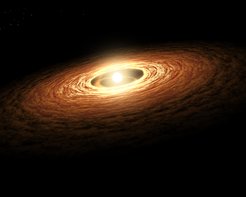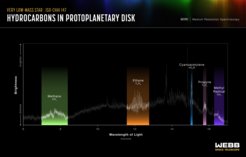Webb Finds Plethora of Carbon Molecules Around Young Star
An international team of astronomers have used the NASA/ESA/Webb James Webb Space Telescope to study the disc around a young and very low-mass star. The results reveal the richest hydrocarbon chemistry seen to date in a protoplanetary disc (including the first extrasolar detection of ethane) and contribute to our evolving understanding of the diversity of planetary systems.

Planets form in discs of gas and dust orbiting young stars. Observations indicate that terrestrial planets are expected to form more efficiently than gas giants in the discs around very low-mass stars. The planetary compositions of these orbiting rocky planets are largely unknown, but new data from Webb suggests that discs around very low-mass stars may evolve differently from those around more massive stars.
The MIRI Mid-INfrared Disk Survey (MINDS) aims to build a bridge between the chemical inventory of discs and the properties of exoplanets. In a new study, this team explored the disc around a very low-mass star of 0.11 solar masses (known as ISO-ChaI-147). These observations provide insights into the environment as well as basic ingredients for such planets to form. The team found that the gas in the planet-forming region of the star is rich in carbon. This could potentially be because carbon is removed from the solid material from which rocky planets can form, and could explain why Earth is relatively carbon-poor.
“Webb has a better sensitivity and spectral resolution than earlier instruments designed to study the Universe from space,” explains lead author Aditya Arabhavi of the University of Groningen in the Netherlands, who is co-supervised by Ewine van Dishoeck. “These observations are not possible from Earth, because the emissions are blocked by the atmosphere. Previously we could only identify acetylene (C2H2) emission from this object. However, Webb’s higher sensitivity and spectral resolution allowed us to detect weak emission from less abundant molecules. Webb also allowed us to understand that these hydrocarbon molecules are not just diverse but also abundant.”
The spectrum revealed by Webb’s Mid-InfraRed Instrument (MIRI) shows the richest hydrocarbon chemistry seen to date in a protoplanetary disc, consisting of 13 carbon-bearing molecules up to benzene. This includes the first extrasolar detection of ethane (C2H6), the largest fully-saturated hydrocarbon detected outside our Solar System. Since fully-saturated hydrocarbons are expected to form from more basic molecules, detecting them here gives researchers clues about the chemical environment. The team also successfully detected ethylene (C2H4), propyne (C3H4), and the methyl radical CH3, for the first time in a protoplanetary disc.

“The disk around this low-mass star is very carbon-rich and oxygen-poor,” says co-author Sierra Grant from the Max Planck Institute for Extraterrestrial Physics. “This could be simply due to the lower temperature of the star, leading to a cooler disk, or that the dust in the accretion disk acts differently, allowing us to look deeper into the disk.” The team is planning follow-up observations, led by MPE, to expand the sample of disks around small stars and even brown dwarfs. “We need to understand why this source is so extreme and how it fits in with other sources,” she adds.
These results could have large implications for astrochemistry in the central region of the disk and the planets forming there. Simulations predict that the sizes and compositions of terrestrial planets are sensitive to the carbon abundance in the protoplanetary disk’s solid material.
This work also highlights the crucial need for scientists to collaborate across disciplines. The team notes that these results and the accompanying data can contribute towards other fields including theoretical physics, chemistry and astrochemistry, to interpret the spectra and to investigate new features in this wavelength range.

